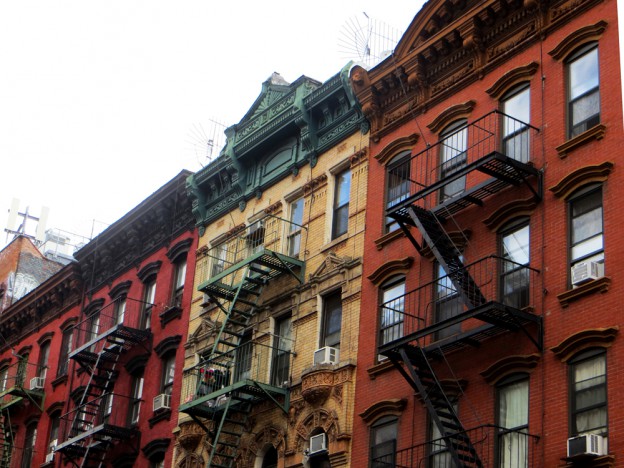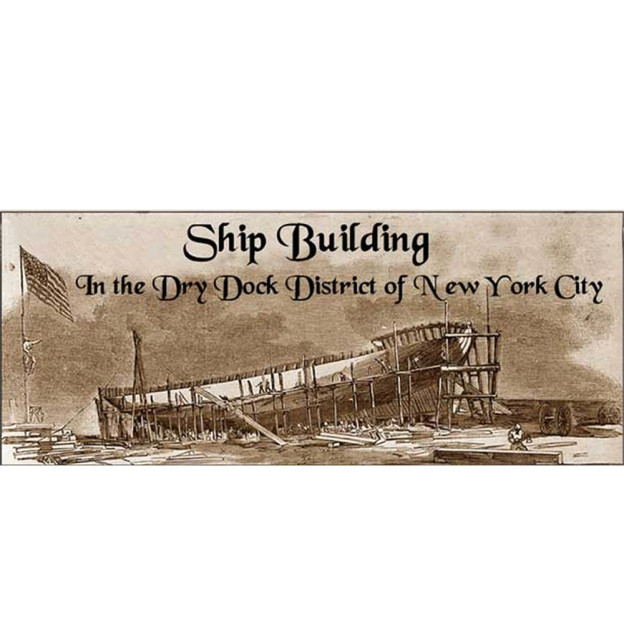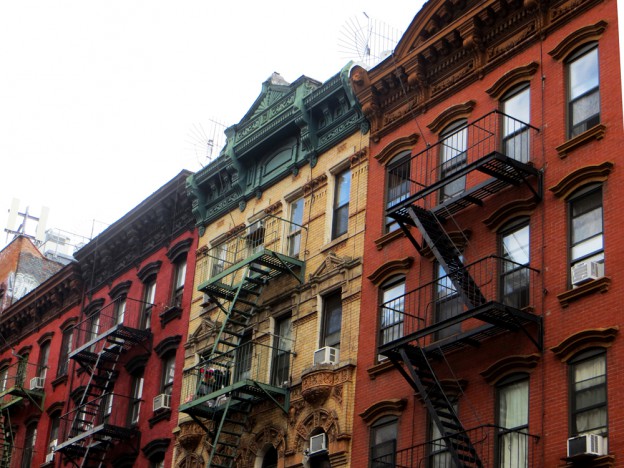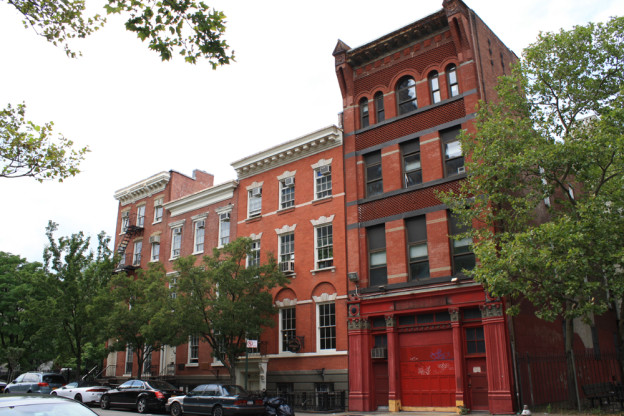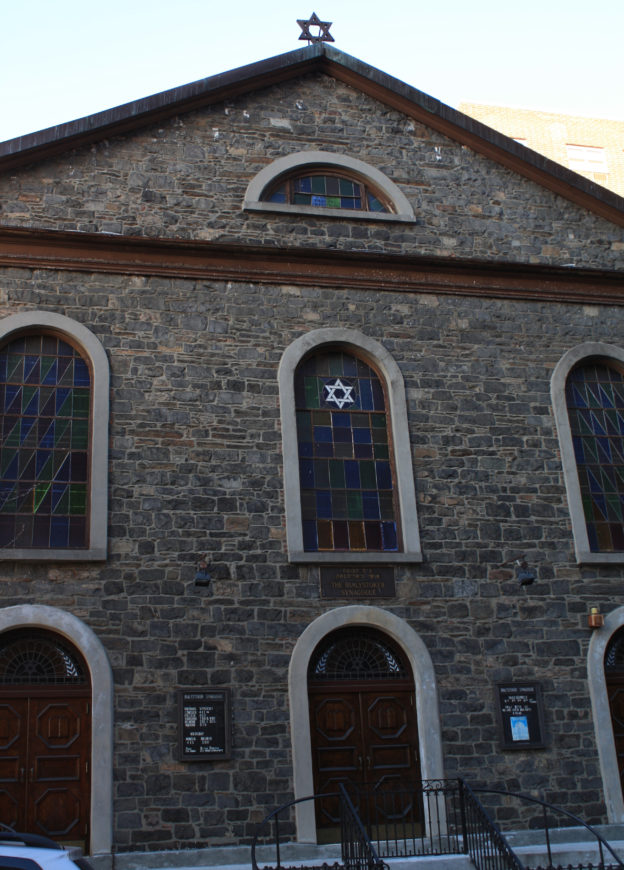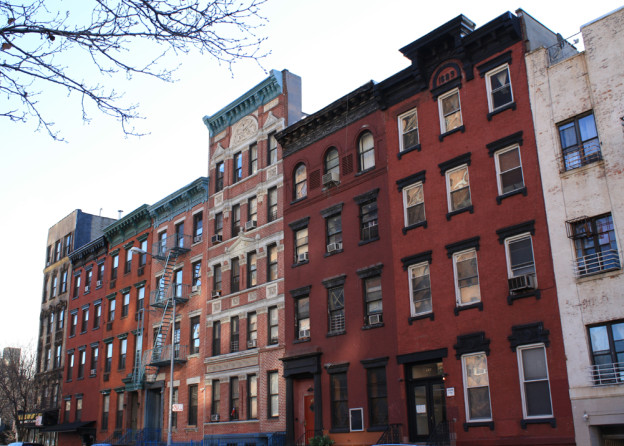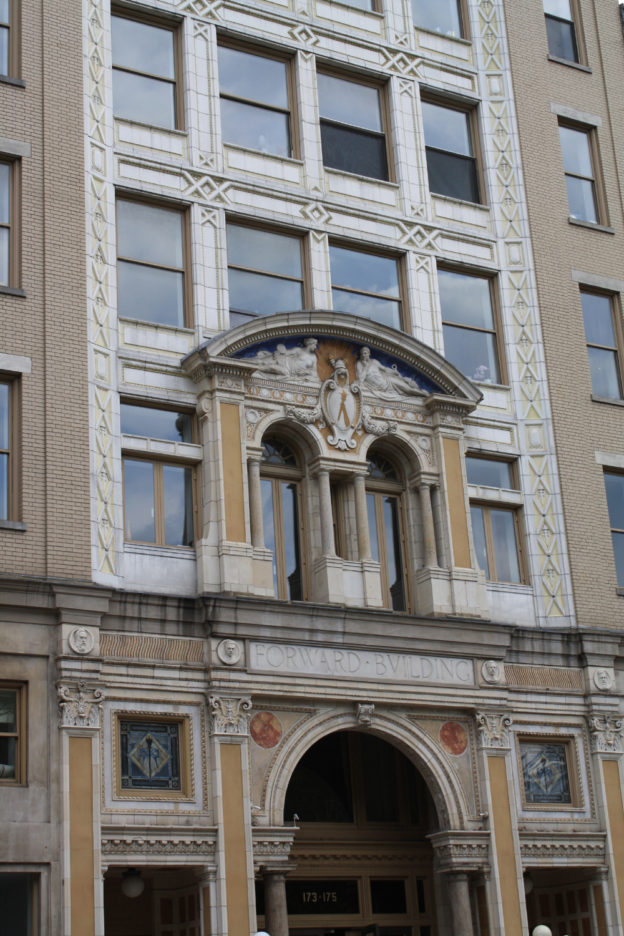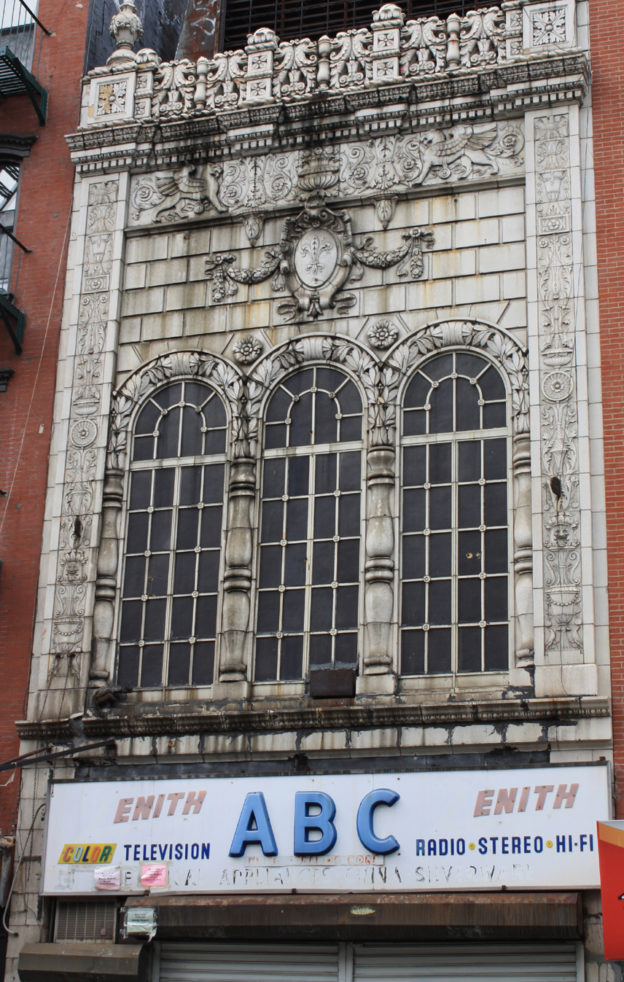Historically, the Lower East Side extended from East 14th Street south to Fulton and Franklin Streets, and from the East River west to Broadway and Pearl Street. Today, the regarded boundaries of the East Village and Lower East Side extend roughly from East 14th Street to the Bowery to the East River, with Houston Street as their north-south divider.
The area’s architecture reflects its early development, with extant examples of early 19th century rowhouses, religious structures, theaters, schools, libraries, banks and settlement houses and the tenement. The East Village contains three New York City historic districts: St. Mark’s Historic District and Extension, East Village / Lower East Side Historic District and East 10th Street Historic District. The latter two were designated in 2012 after a robust advocacy and outreach effort by community groups and preservationists. At the time of this publication, there are no locally designated historic districts in the Lower East Side.
To learn more about East Village/Lower East Side click here
Lower East Side Preservation Initiantive &
Art Loisaida Foundation
present
LESPI presents Ship Building in the Dry Dock District in New York City
Thursday, January 29, 2015
6:30-8:30 pm
Neighborhood Preservation Center
232 East 11th Street
(btn. 2nd and 3rd Avenues)
presented by
Laura Zelasnic
Amazingly, what we now know as the East Village’s Alphabet City was part of a huge shipbuilding district, which during the 19th century produced and launched many of our country’s most beautiful and important ships – clippers, ironclads, steamships and more. There are now only a very few reminders left of this once thriving industry.
Come hear Laura Zelasnic reveal this fascinating history, wonderfully illustrated with period images.
Admission: $15 / $10 LESPI members
The lecture will be followed by a short reception. Light refreshments will be served.
For further information contact Richard at info@LESPI-nyc.org or 347-827-1846.
Seats are limited: reservations recommended.
Make a reservation online HERE.
This program is made possible in part by public funds from The NYC Dept. of Cultural Affairs in Partnership with the New York City Council-(Many thanks to Rosie Mendez, NYC Councilperson) and and the NYS Assembly in partnership with NYS Dept of Parks (many thanks to the Honorable Brian Kavanagh)
http://us2.campaign-archive2.com/?u=83f9475af0eb0d590581eb33d&id=6f3f82cdd8&e=250751cbe4
Presented by:
Marcia Haddad Ikonomopoulos
Director of the Museum at Kehila Kedosha Janina and LESPI Board Member
This program illuminates a little-known part of the American immigration story – that of the immigrants from Greece.
Step into the Balkan world of the Lower East Side, the kafenions and dance halls, the lilting bouzouki music and the aromas of Mediterranean cooking. Learn about the Sephardic and Romaniote synagogues and the local Greek Orthodox Church. They came during the massive wave of immigration (1881-1924) but their stories were very different.
Suggested donation: $15
Wednesday, October 1, 2014
6:30-8:30pm
Neighborhood Preservation Center
232 East 11th Street
(btw. 2nd and 3rd Avenues)
The lecture will be followed by a short reception. Light refreshments will be served.
For further information contact Richard at info@LESPI-nyc.org or 347-827-1846.
Space is limited RSVP are required – Make a reservation online HERE.

In Celebration of the First Annual Lower East Side History Month
Saturday, May 10, 2014, 12 noon – 2:00 pm
(Rain Date Saturday, May 17 – check website: friendsofthelowereastside.org)
Begins and ends on the Southeast corner of Delancey and Orchard Streets (F, J, M, Z trains to Delancey Street/Essex Street Station)
Cost: Free – Attendees MUST register by May 7 with all names to: friendsoftheles@gmail.com
“The Lower East Side is where millions of immigrants have taken their first steps in the New World on the road to the American Dream,” wrote Joyce Mendelsohn, our tour guide and author of the definitive guidebook to the area, The Lower East Side Remembered and Revisited. Although endangered, a number of blocks south of Delancey Street still retain the sense of place that would be familiar to our immigrant ancestors. The tour will focus on the history and architecture of the historic neighborhood with particular attention to the housing, institutions and businesses that were the center of immigrant life. The guided tour will highlight the impact of housing reforms reflected in the changes to the plans and features of tenements over time. “We will see pre-Old Law, Old Law and New Law tenements and look up at the elaborate terra cotta ornamentation that distinguishes many buildings,” said Mitchell Grubler, the tour’s co-leader.
The structures that housed some of the institutions and businesses which served the multitudes of immigrants will also be highlighted. The tour will pass a Neo-Renaissance style school designed by architect, C.B.J. Snyder in 1897; the former Independent Kletzker Brotherly Aid Society built in 1911; the 12-story former Jarmulowsky Bank of 1911-12; as well as a number of other significant buildings.

Howells & Stokes, 1898-99; addition: DeLemos & Cordes, 1904;
197 East Broadway Brunner & Tyron, 1889-91;
Henry Street Settlement: 301 Henry Street, DeYoung, Moscowitz & Rosenberg, 1962;
263 and 265 Henry Street, 1827;
267 Henry Street, 1834, new façade: Buchman & Fox, 1910;
Engine Company No. 15, 269 Henry Street, Napoleon LeBrun & Sons, 1884;
281 East Broadway, 1829|
The Settlement House movement began in the 1880’s in response to worldwide urban poverty sparked by industrialization and immigration. Settlement houses provided education, recreation, medical services and social welfare programs to residents of city slums. The Neighborhood Guild, founded in 1886 as America’s first settlement house, brought male university graduates to the Lower East Side to help and inspire the poor. The Guild changed its name to University Settlement in 1891. Founded by Jewish philanthropists, the Downtown Hebrew Institute was founded in 1889 to transform new Jewish immigrants into assimilated members of their new society. Its name was changed to the Educational Alliance in 1893. Many settlement houses were staffed by educated women, including the Henry Street Settlement, which was founded in 1893 by advocate Lillian D. Wald and funded by Mrs. Solomon Loeb and her son-in-law, banker and philanthropist Jacob Schiff. All three of these settlement houses are still in operation today. In 2007, Henry Street Settlement acquired Engine Company No. 15, one of many firehouses designed by Napoleon LeBrun & Sons and commissioned by the City between 1878 and 1894. The site has a storied past, as it was previously home to a brownstone dwelling converted in 1854 into the Americus Engine Company No. 6, or the “Big Six”, which William M. “Boss” Tweed organized and used as a vehicle for his infamous political exploits. Each of the Henry Street Settlement address are New York City Individual Landmarks. 263 and 265 Henry Street and 267 Henry Street are both listedon the State and National Register of Historic Places.
7-13 Bialystoker Place, 1826 – NYCIL & Nat’l Reg Property;
290 Henry Street, contributed to John Heath, 1827-29 – NYCIL & Nat’l Reg Property|
These two churches, located a few blocks apart, are two of the four surviving fieldstone religious structures built in the late Federal era in lower Manhattan. Their fieldstone was quarried from Mount Pitt, a hill that once stood at the present corner of Pitt and Grand Streets. Their simple exteriors give way to ornate and fascinating interiors. Bialystoker Synagogue, originally the Willett Street Methodist Episcopal Church, has a richly hued interior with statuary and paintings. A concealed corridor discovered during renovations in the 1990’s led to speculation that the building was a safe house on the Underground Railroad. St. Augustine’s, originally the All Saints’ Free Church, houses the old High Altar from Trinity Church, the Lady Altar from St. Augustine’s Chapel on East Houston, the pulpit from the demolished St. John’s Chapel in Hudson Square, and enclosures around the organ that were once designated seating for black parishioners. Both churches are New York City Individual Landmarks and listed on the State and Nation Register of Historic Places.
c. 1837|
These Greek Revival rowhouses are rare survivors of their period of construction in the early 19th century, and stand as reminders of the time before large numbers of immigrants began settling into the Lower East Side. Each house was built for a single wealthy family, as evidenced by the fancy ironwork on number 247.
173-175 East Broadway, George A. Boehm, 1912|
Located on a stretch of East Broadway once known as “Yiddish newspaper row”, this was the headquarters for Vorwärtz, or the Jewish Daily Forward, the most widely read Yiddish newspaper in the United States. First published in 1897, it was immensely influential on the Jewish community for its support of socialist causes and for its articles offering advice on everyday struggles, making the most of America’s opportunities and encouraging children’s education. The terra cotta-clad building features medallions with faces of socialist heroes Karl Marx, Friedrich Engels, Karl Liebknecht and Ferdinand Lassalle above the entry, Vorwärtz in Yiddish at the building’s crown, and a clock at the parapet. The paper moved uptown in 1974 and the building was converted to condominiums in the 1990’s. The Forward Building is a New York City Individual Landmark.
Canal Street to Hester Street, between Essex and Jefferson Streets established 1899;
Straus Square, intersection of East Broadway, Essex, Canal and Rutgers Streets|
In the late 1890’s, the Outdoor Recreation League lobbied the City to clear several blocks for Seward Park, which opened in 1899. The park was named for politician William H. Seward, a strong supporter of immigrants, who in turn supported his successful campaigns for State Senate, Governor and U.S. Senate. The City took over management of the park in 1903 and created a permanent municipal playground, the nation’s first. The park also featured a children’s farm garden and a public bathhouse, which was replaced in 1941 with a recreation building. Straus Square was originally named for patriot Henry Rutgers, whose hundred-acre farm was nearby. Both Henry and Rutgers Streets and Rutgers University are also named for him. The square was a political epicenter, regularly hosting rallies and demonstrations. In 1931, the square was renamed for German Jewish philanthropist and advocate Nathan Straus, whose family owned Macy’s and Abraham & Straus department stores.
31 Canal Street;
Thomas W. Lamb, 1926-27|
This movie house was designed in the Spanish baroque style and originally held 2,270 seats, offering a welcome distraction and escape from daily life in the tenements until it closed in the 1960s. The glazed white terra cotta façade, dominated by three arched faux windows in the center, is graced with rich Classical ornament in the form of wreaths, urns, griffins and foliage. The Former Loew’s Canal Street Theatre is a New York City Individual Landmark.

